I’d finished my second year of university and was a month into my summer job when mountain-fever hit me. Sitting at a desk—whether studying or working—was giving me an urge to get a breath of fresh air and stretch my legs. It wasn’t hard to convince Mom to go along; we searched through The Canadian Rockies Trail Guide and found a trail we wanted to hike.
The start of the May long weekend found us at the Banff park office, trying to register for the trail despite the grey weather. That was when we found out that the trail we wanted to hike was still snowed in. So was every other trail in the park, except for Lake Minnewanka. And the only campground available on Lake Minnewanka for that night was twenty kilometres in.
My brain thought back over the past two years of sitting at a desk. Before I could say “maybe not,” Mom enthusiastically said, “Sure!” In a few seconds, we were registered for two nights at Narrows Campground. Twenty kilometres, I thought. Okay.
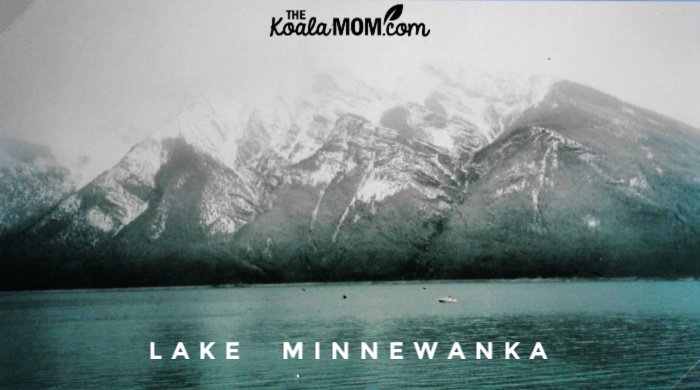
Hiking in to Lake Minnewanka
The sun was starting to peek out of the clouds as we drove up to the Lake Minnewanka trail head and pulled our packs and boots from Mom’s Toyota 4Runner. Within fifteen minutes, we were heading down the trail in high spirits. The lake was that beautiful turquoise colour of mountain lakes; the air was fresh with the smell of pine and evergreen; and it was even warm enough we didn’t need our jackets.
The trail along the north shore of Banff’s largest lake is attractive to early and late season backpackers since its low elevation and location in the Front Ranges usually provides dry, snow-free hiking from May until mid-autumn. ~ Brian Patton and Bart Robinson, The Canadian Rockies Trail Guide
We kept up our steady 4-km an hour pace. By late afternoon, the air had cooled and we stopped to pull out our jackets. Then we rounded a corner in the lake and walked straight into a snowstorm.
Heavy, wet flakes flew horizontally towards in. They stuck to our pants, our packs, our boots, until we looked like abominable snowmen. We had the entire trail to ourselves and looked forward to arriving at Narrows Campground, just this side of a pass called Devil’s Gap.
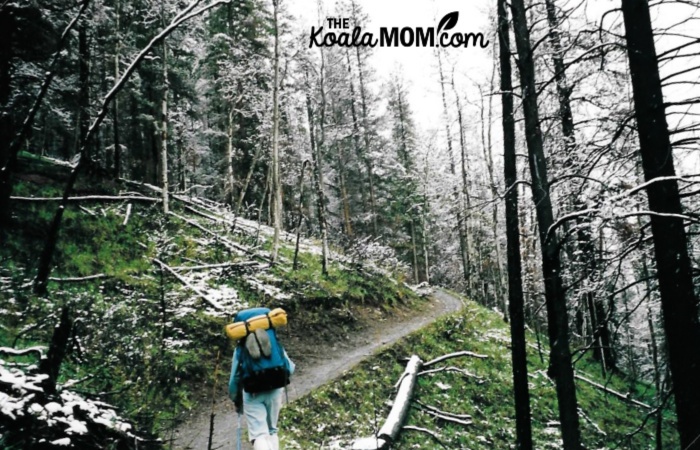
When we finally reached the empty campground, early in the evening, we made our supper quickly. As the snow continued to fall, we tried to start a fire. After all our backcountry skills failed to get the wet wood burning, we dumped stove fuel on it and then sat around warming our hands.
The wind continued to howl towards us from Devil’s Gap. We began talking about our options. We could take it easy tomorrow, stay close to camp to see if the weather cleared, and just hike the next few kilometers to Devil’s Gap and the park boundary…
Too cold to sit out in the wind any longer, we crawled into our sleeping bags around 8 pm and tried to get to sleep.
We were up early the next morning to find that our 20-year-old tent wasn’t quite as waterproof as it had once been. Parts of our Thermarests and sleeping bags were soaked. The tent and campground were coated with several inches of wet snow. And the wind still howled from Devil’s Gap.
You may also like: Four Days Hiking the Skoki Valley in Banff National Park
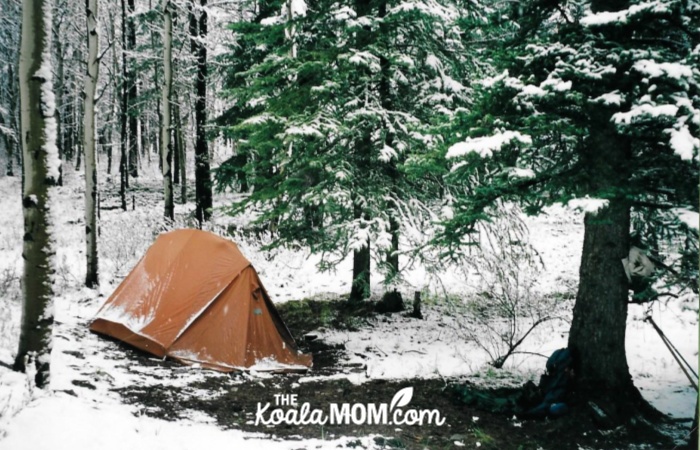
Hiking out again
We ate our hot instant oatmeal and decided to hike out. There was no reason to sit around Lake Minnewanka in the cold and snow, especially with wet gear. In less than an hour, we’d broken camp and hit the trail, letting the activity warm us up.
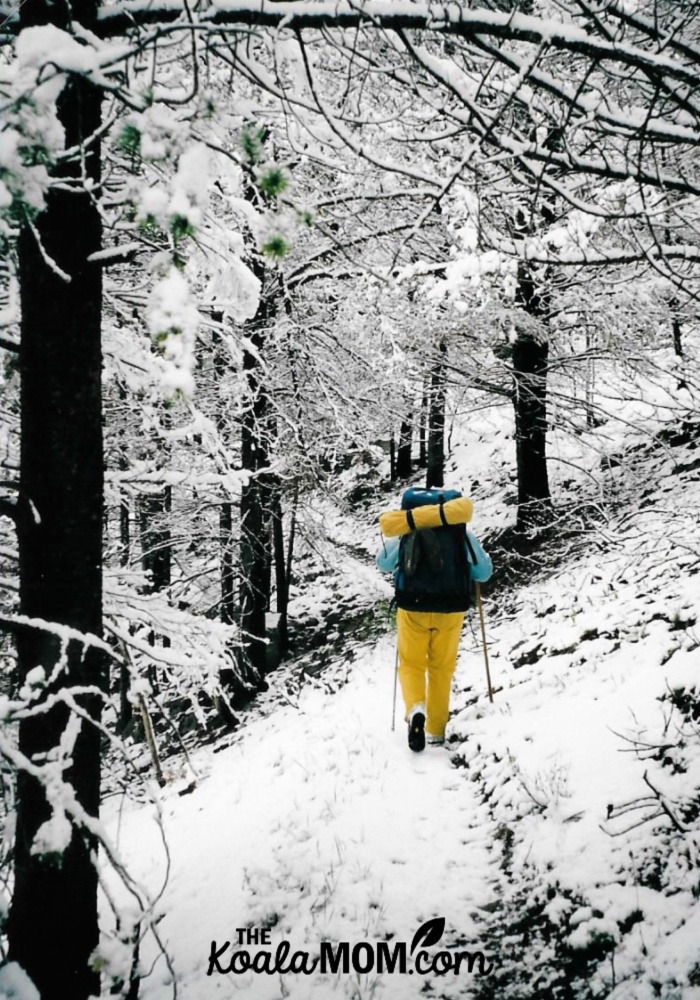
As soon as we got around that corner of Lake Minnewanka, we walked into nice weather again. It was like we’d stepped into a completely different world. We debated stopping at Aylmer Campground at 11 km.
However, we still had wet gear and we weren’t sure that anyone else in the campground would have also decided to give up on the weather and hike out. I didn’t want to sit around for a few hours to see if there were empty campsites for the evening, and then have to hike out later when all the sites filled up. So we continued on.
Somewhere around 8 km from the Lake Minnewanka trailhead, I was done. Every muscle in my body ached. My pack was impossibly heavy. Eight kilometers seemed like a thousand. Mom was still chipper, chattering about the trail and the scenery, and I could only think about putting each foot in front of the other, of making it to the 4Runner and then back to Grandma and Grandpa’s. Teeth gritted, head down, I walked.
Those were the longest 8 km I’ve ever hiked. The parking lot was a welcome sight. I threw my pack into the back of Mom’s 4Runner and collapsed into the front seat. I’d made it.
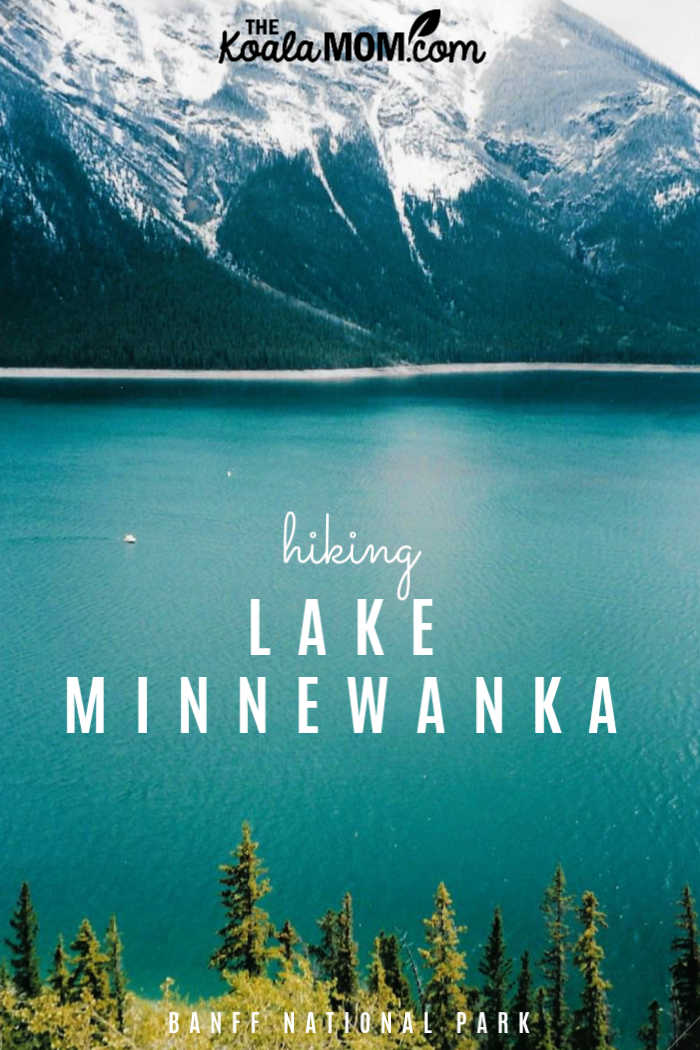
Lessons from Lake Minnewanka
Lake Minnewanka still comes to my mind when I face something that seems impossible. I pushed myself that day, pushed myself to the limits of my physical abilities and then beyond, and I did it. Hiking 40 km in two days may seem like a little feat or a big feat to others. What mattered was that, even though it was hard at the time, I kept going and I succeeded.
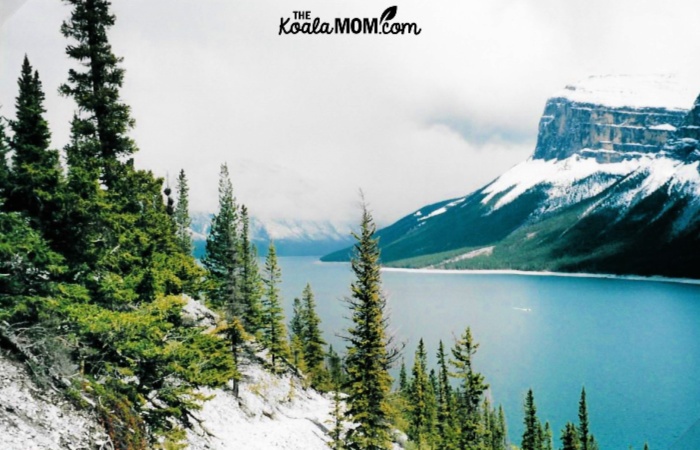
I’ve thought of Lake Minnewanka while birthing each of my babies. Dr. Robert Bradley compares labour to running a marathon, recommending that women get in shape to do either. Sure, childbirth is tough; but I’ve done tough things.
When I was in labour with Sunshine, I hit a point where I wanted to quit, thought I couldn’t do it anymore. At the same time, like when I hiked Lake Minnewanka, I knew there was no way out but to keep going—and I knew that I could do it, because I’d done it before.
What’s the hardest hike or physical activity you’ve ever done? What else has it inspired you to do?

No Responses Yet